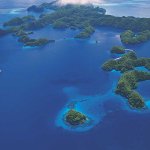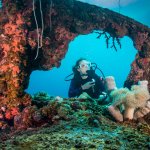Palau
Overview
A diver’s Mecca. Rated as one of the world’s best diving destinations, Palau’s tropical waters are legendary amongst divers. Featuring underwater natural wonders, Palau beckons avid divers to its islands of pure beauty, clear waters, thriving shallow reefs and WWII wrecks that feature their own marine-life ecosystem.
Palau beckons to you with some of the world’s most awesome natural wonders. Imagine the whitest beaches you will ever see, gardens of coral just beneath the clearest waters, lakes filled to the brim with “sting less” jellyfish. Forests, waterfalls and caves that have never been ravaged by man and hundreds of islands of the purest beauty abound all along the pristine archipelago.
Palau has three ocean currents converging in its waters to bring in some of the most varied and dazzling marine life in the world. Palau is also blessed with a rich diversity of plants & birdlife. Tropical forest covers much of the islands, species of trees include ironwood, banyan, coconut palm and pandanus. Kayaking or canoeing is the perfect way to explore the hidden network of saltwater lakes, mangrove forests, marine tunnels, tropical beaches and caverns.
Palau’s warm tropical waters are legendary amongst divers for their dramatic sheer walls rising from the depths to within inches of the surface and capped with thriving coral reefs.
It is common to see 30 – 50 grey reef and whitetip sharks, eagle rays, hundreds of schooling barracuda, thousands of blue trigger fish, moray eels, lion fish, schooling humphead parrotfish, nudibranchs, several turtles and a leaf fish all on one dive.
Palau is home to over 1,300 species of fish and more than 700 species of coral. World renowned for its’ marine bio-diversity and abundance of large pelagic animals, Palau also offers avid wreck divers one of Micronesia’s largest collections of WWII shipwrecks.
From current swept plateaus to sheltered coral gardens, Palau offers a wonderful range of diving for every level of interest and skill. The majority of diving in Palau is drift diving along the walls, plateaus and coral gardens of the outer reef, with the dive boat following along from the surface to meet you upon ascent. Experience the sites that make Palau one of the top dive destinations in the world: the sharks of Blue Comer, the manta rays of Devilfish City and German Channel, and the coral reefs and stunning drop offs teeming with marine life.
Dive Sites
Blue Corner
As its name suggests, Blue Corner is – a corner. It juts out from the reef, starting in shallow water and dropping off to well over 1,000 feet. The corner plateaus at 60 feet/18meters, creating a strong current as the flow of water comes across this outcropping of coral. The currents, changing with the tides, can approach the corner from either the north or the south, with the speed of the current changing based on the moon.
As you swim to Blue Corner you will have the wall on your side. As you get to the plateau you cross on top of the reef. Pick a spot on the reef near the edge and use your reef hook to minimize damage to the reef. You might hang there in the current for ten minutes or more just watching the action. Sharks will circle over and over allowing you the opportunity to photograph or just observe them up close and personal. You will mainly see two species of sharks during the dive, the gray reef shark and the white tip shark.
Chandelier Cave
Chandelier CaveCalcium carbonate laden rainwater, seeping through the limestone above, formed the cave that Palauans call Liel Temekai – the “Cave of the Grouper”. The cave consists of three air filled chambers in a straight line, with a single entrance and exit. There are NO side tunnels or caves to get lost in – and the exit can be seen at all times. Diving lights, which can be rented for a small fee, are required inside the cave. The deepest part of the dive is 30 feet (10m), with the majority of the time spent in at the surface inside each chamber. Each chamber is spectacular in its own way. You will see magnificently coloured flowstones and crystalline stalactites in each of them, as well as some dipping below the surface of the water. Stalactites are still forming in each of the three chambers. As you exit the cave you may catch a glimpse of a mandarin fish – one of the rarest and most beautiful fish in Palau. With a little patience and a good eye you will b e able to see this very colourful fish, as well as nudibranchs and signal gobies.
The darkness can be overwhelming for someone who has not dived in a cave before. But as you swim toward the walls and ceiling you’ll see the stunning stalactites come into focus and they pierce the still water surface, mirroring into the darkness.
German Channel
German Channel was built in the 1900’s, when the German administration blasted through the reef to complete the natural channel and allow ships to pass from the southern islands of Peleliu and Angaur to Koror. Today it is used as passage through the south-western barrier reef to many of the outer dive sites. At 10 feet (3 meters), the man-made channel is too shallow to dive. The outside mouth of the channel slopes down to a sandy bottom at about 75 feet. This dive is popular for its manta cleaning station, where the manta, and the occasional reef shark come to be cleaned by cleaner wrasse. You can also see other kinds of rays including sting rays, spotted eagle rays, and ornate eagle rays.
Ulong Channel
The best time to dive Ulong Channel is on an incoming tide and preferably when the incoming current is strong. There are three things about this dive that make it special:
- A beautiful wall with nice table corals.
- lots of shark action at the mouth of the channel.
- the drift along the channel itself.
If the current is strong there will be as many or more sharks concentrated at the mouth of the channel as at Blue Corner on a good day.
Peleliu Wall
BIG fish can swim by any time on this dive. There are white tip and black tip reef sharks in abundance, as well as bigger sharks like hammerheads or silvertips. The wall is entirely covered with healthy, beautiful soft corals.
Big Dropoff (Ngemelis Wall)
Big Dropoff has some of the most beautiful soft corals and sea fans that Palau has to offer, as well as many small reef fish, including the unusual square spot anthias and thousands of pyramid butterfly fishes. There are also some turtles, beautiful anemones, clown fish, and the occasional shark – mainly white tip reef sharks. The deeper water Big Dropoff is often patrolled by gray reef sharks, rays, turtles and large schools pyramid butterfly fish.
Gallery
We'll find you the best value deals in the most amazing destinations. Let your active travel journey start with us!




